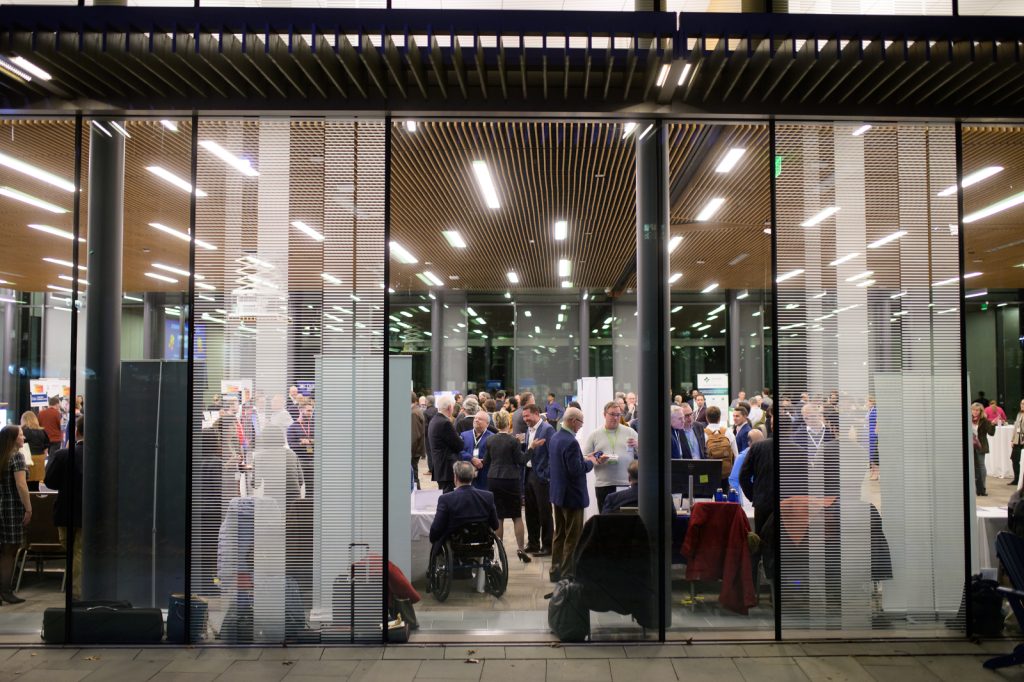What do a smart toilet, an analog film app, and metamaterial computer chips have in common? They were all invented at Duke!
The Office for Translation & Commercialization—which supports Duke innovators bringing new technologies to market—recently hosted its fifth annual Invented at Duke celebration. With nine featured inventors and 300 attendees, it was an energetic atmosphere to network and learn.

When event organizer Fedor Kossakovski was selecting booths, the name of the game was diversity—from medicine to art, from graduate students to faculty. “Hopefully people feel like they see themselves in these [inventors] and it’s representative of Duke overall,” he said. Indeed, as I munched through my second Oreo bar from the snack table and made the rounds, this diversity became apparent. Here are just two of the inventions on display:
Guided Medical Solutions
The first thing you’ll notice at Jacob Peloquin’s booth is a massive rubber torso.
As he replaces a punctured layer of rubber skin with a shiny new one, Peloquin beckons us over to watch. Using his OptiSETT device, he demonstrates easy insertion and placement of a chest tube.
“Currently, the method that’s used is you make an incision, and then place your fingers through, and then take the tube and place that between your fingers,” Peloquin explained. This results in a dangerously large incision that cuts through fascia and muscle; in fact, one-third of these procedures currently end in complications.
Peloquin’s device is a trocar—a thin plastic cylinder with a pointed tip at one end and tubing coming out of the other. It includes a pressure-based feedback system that tells you exactly how deep to cut, avoiding damage to the lungs or liver, and a camera to aid placement. Once the device is inserted, the outer piece can be removed so only the tubing remains.

Peloquin—a mechanical engineering graduate student—was originally approached by the surgeons behind OptiSETT to assist with 3D printing. “They needed help, so I kind of helped those initial prototypes, then we realized there might be a market for this,” he said. Now, as he finishes his doctorate, he has a plethora of opportunities to continue working on OptiSETT full-time—starting a company, partnering with the Department of Defense, and integrating machine learning to interpret the camera feed.
It’s amazing how much can change in a couple years, and how much good a rubber torso can do.
GRIP Display
This invention is for my fellow molecular biology enthusiasts—for the lovers of cells, genes, and proteins!
The theme of Victoria Goldenshtein’s booth is things that stick together. It features an adorable claw machine that grabs onto its stuffed animal targets, and a lime green plastic molecule that can grab DNA. Although the molecule looks complex, Goldenshtein says its function is straightforward. “This just serves as a glue between protein and the DNA [that encodes it].”

Goldenshtein applies this technology to an especially relevant class of proteins—antibodies. Antibodies are produced by the immune system to bind and neutralize foreign substances like disease. They can be leveraged to create drug therapies, but first we need to know which gene corresponds to which antibody and which disease. That’s where GRIP steps in.
“You would display an antibody and you would vary the antibody—a billion different variations—and attach each one to the system. This grabs the DNA,” Goldenshtein said.
Then, you mix these billions of antibody-DNA pairs with disease cells to see which one attaches. Once you’ve found the right one, the DNA is readily available to be amplified, making an army of the same disease-battling antibody. Goldenshtein says this method of high-throughput screening can be used to find a cancer cure.
Although GRIP be but small, its applications are mighty.
Explore Other Booths
- Coprata: a smart toilet that tracks your digestive health
- inSoma Bio: a polymer that aids soft-tissue reconstruction
- Spoolyard: a platform for exploring digital footage with analog film techniques
- FaunaLabs: smart watches for our furry friends
- G1 Optics: a tonometer to automatically detect eye pressure
- TheraSplice: precision RNA splicing to treat cancer
- Neurophos: metamaterial photonics for powering ultra-fast AI computation
As I finished my last Oreo bar and prepared for the trek back to East Campus, I was presented with a parting gift—a leather notebook with “Inventor” embossed on the cover. “No pressure,” said the employee who was handing them out with a wink.
I thought about the unique and diverse people I’d met that night—an undergraduate working in the Co-Lab, an ECE graduate student, and even a librarian from UNC—and smiled. As long as we each keep imagining and scribbling in our notebooks, there’s no doubt we can invent something that changes the world.

Post by Michelle Li, Class of 2027


